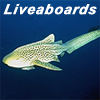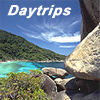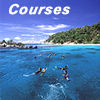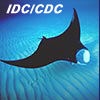Reef Ecology Guide Phuket Thailand - Cnidarians 1
CNIDARIANS (Cnidaria)

All members of the phylum Cnidarians are characterized by tentacles
armed with a myriad of stinging cells. Each of these cells is equipped
with a minute safety pin (cnidocil), which acts as a trigger mechanism.
Whenever potential prey touches the tentacles, cnidociles get bent,
which in turn leads to an instantaneous avalanche of stinging cells
being ejected.
In this process, a bundle of knife-like appendages
extend, cutting into the prey's skin. Immediately thereafter
a long filament from inside the cell penetrates the cut and injects
a toxin to paralyze or kill the prey.
All this is microscopically
small and happens a million times in a few seconds.
STONY CORALS (Scleractinia)

Millions upon millions of tiny coral polyps are the life blood of the reef. The skeletons they secrete by countless generations form the solid limestone foundation or platform on which the reef flourishes.
An individual coral polyp consists of a fleshy sack topped with a ring of tentacles around a central mouth opening. It sits in a limestone skeletal case, which is actually secreted by the polyp. Members of the colony are linked together by living tissue. Therefore nutrients captured by a section of the colony can be shared around.
Stony corals have brownish colored, unicellular algae living within the tissues of the polyps. The algae use sunlight and carbon dioxide to produce carbon enriched organic compounds (sugar). These in turn are leaked to the polyp and may provide as much as 98 percent of its nutritional requirements.
Stony corals typically grow in clear, sunlit waters. Some are also found in relatively low light levels. They grow slowly and their diet may be supplemented by absorbing nutrients directly from the water or by feeding on bacteria and organic debris.
FORMOSA STAGHORN CORAL (Acropora formosa)

Very common, often the dominant species of lagoons and fringing reefs. Colonies arborescent, forming thickets.
Occur in different colors like cream, brown or blue. Branch ends often pale.
SOLID TABLE CORAL (Acropora clathrata)
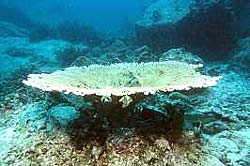
The branches of this species form an almost solid plate.
It has a light skeleton, which allow them to grow quickly and to overcome their neighbors.
MUSHROOM CORAL (Fungia fungitis)
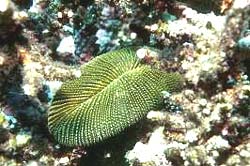
Very common species, not attached, on upper reef slopes exposed to surge.
The ridges have triangular teeth.
BRAIN CORAL (Leptoria phrygia)

Mostly occurring in single colonies down to 15 m depth.
The colonies
ORANGE CUP CORAL (Tubastrea coccinea)

The commonest cup coral seen by divers because it grows in areas exposed to currents and not in caves like the other genus members.
SOFT CORALS & SEA FANS (Alcyoniidae)

Soft corals and their relatives are a prominent part of the reef scene. In some places they may form extensive growth, like vast fields of undersea wildflowers. Structurally they are similar to stony corals.
Both contain colonies of polyps that gather planktonic food. However, as their name suggests, soft corals lack a hard skeleton. Instead, the supporting stem consists of fleshy tissue that is reinforced by a matrix of microscopic calcareous particles.
Soft corals have tiny side branches on the tentacles in contrast to the smooth tentacles of hard corals. Moreover, soft corals generally have eight tentacles compared to six or multiples of six found in hard corals.
Most soft corals are various shades of green, yellow and brown. The color is largely attributable to the presence of single celled algae that live within their tissue.
GIANT SEA FAN (Anella mollis)

This species has a flexible uni-plane skeleton.
Normally found growing on drop-offs, reaching far out into the open water.
KNOTTED FAN CORAL (Melithaea ochracea)
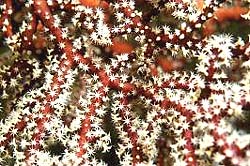
The colonies are fan-shaped with a thick main stem, dividing in many sub-branches.
The polyps are distributed over the entire surface. Coloration is variable, mainly deep red with white polyps.
Grows on slopes and drop-offs, also on deeper reef terraces. Feeds on micro plankton.
RED WHIP CORAL (Junceella sp.)

Whip-like gorgonians with heavily calcified horny axis. Found in groups on reef slopes.
Sexes are separate, but also asexual reproduction by budding. Buds fall down and grow to become neighbors of the parents.
KLUNZINGERS SOFT CORAL (Dendronephthya klunzingeri)
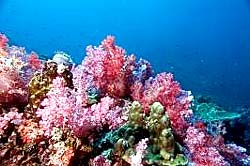
Wide spread species of soft coral. Red calcareous sclerites show as loosely distributed spines in the translucent body wall.
Coloration pink to violet. On hard substrate, nocturnal plankton feeder.
BLACK CORAL (Antipathes sp.)

They show a variety of branched or whip-like forms, which resemble gorgonians.
The name is derived from the color of the inner skeleton. Living colonies never appear black under water.
Dive Asia - Phuket Thailand
Office Address: 8/30 Soi Yodsanee, Chalong, Phuket 83150, Thailand
Phone: +66 (0) 818948588 or 0899736005
Visit us at one of our Offices: (Google Map)
Email:
Website: www.diveasia.com
24 Hour Hotline: +66 (0) 818948588









